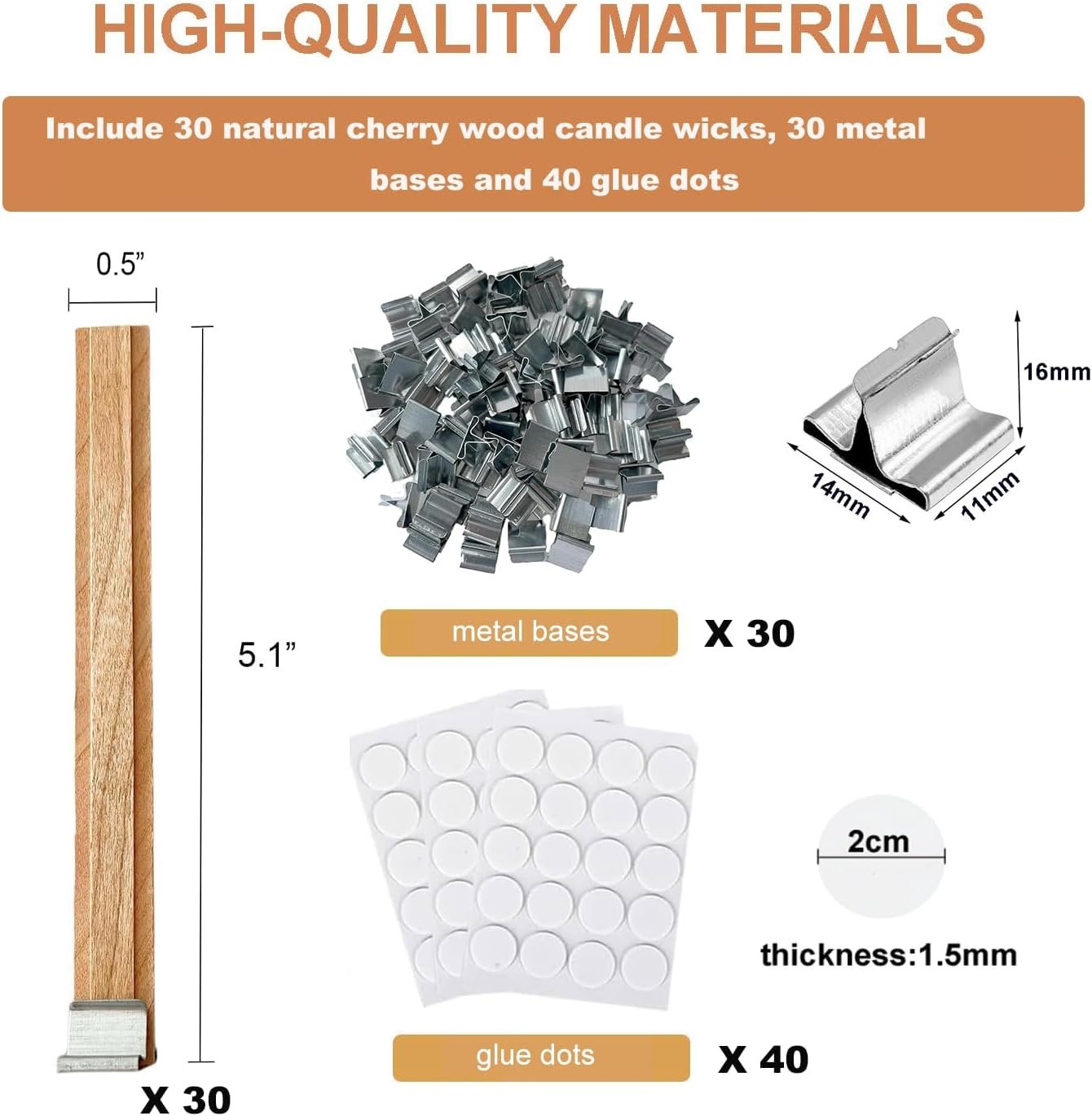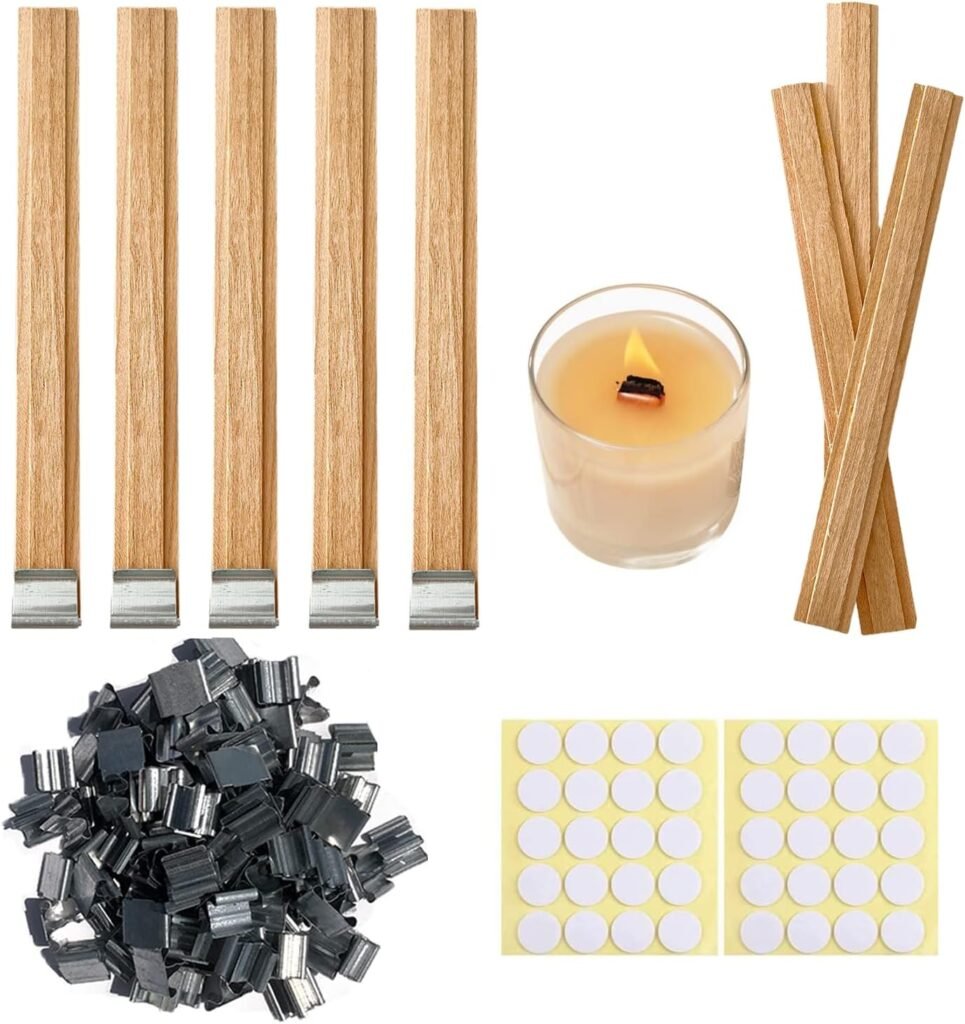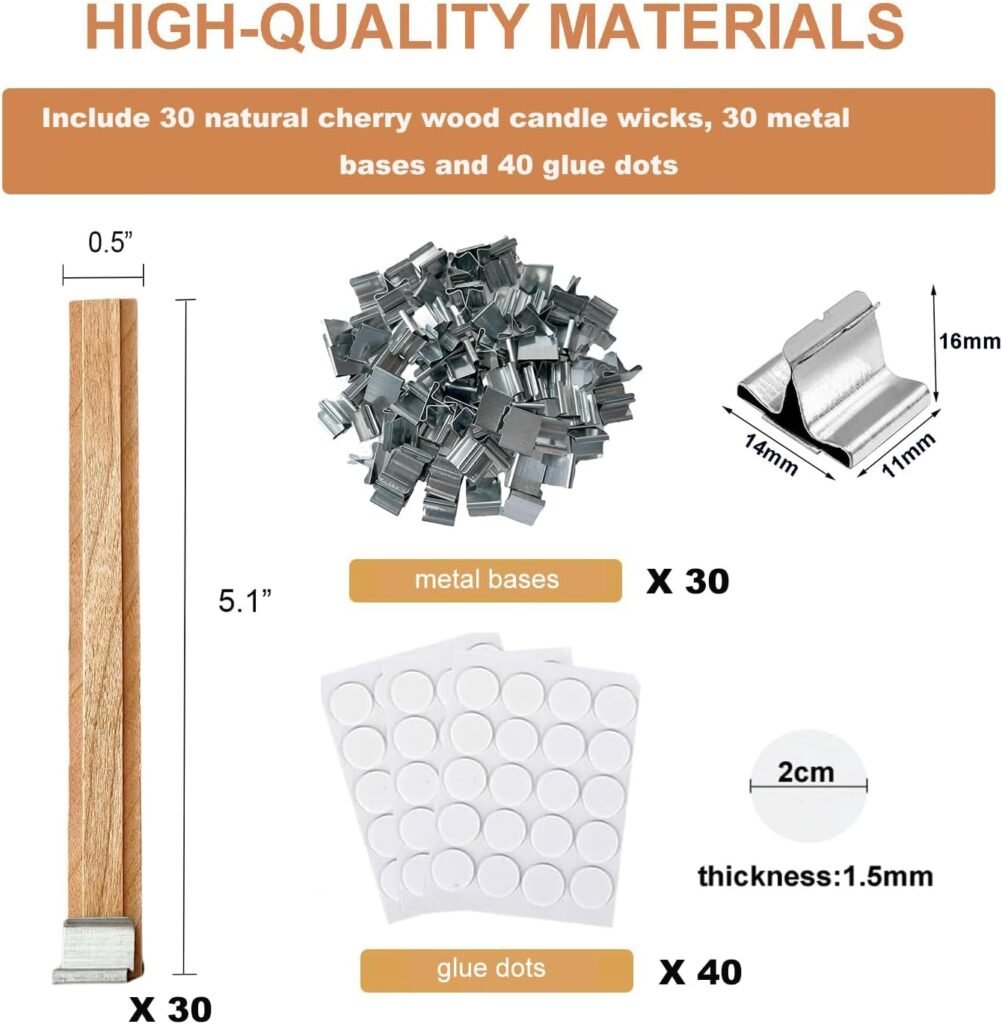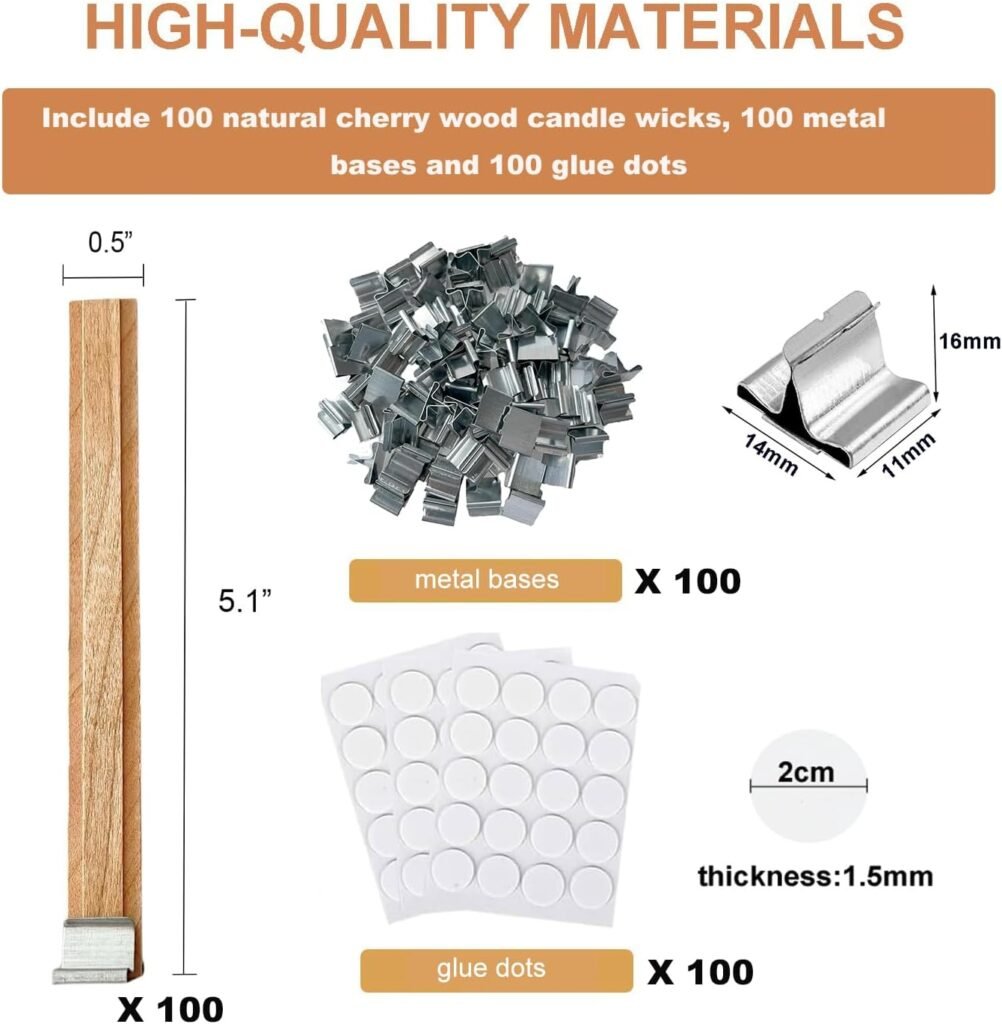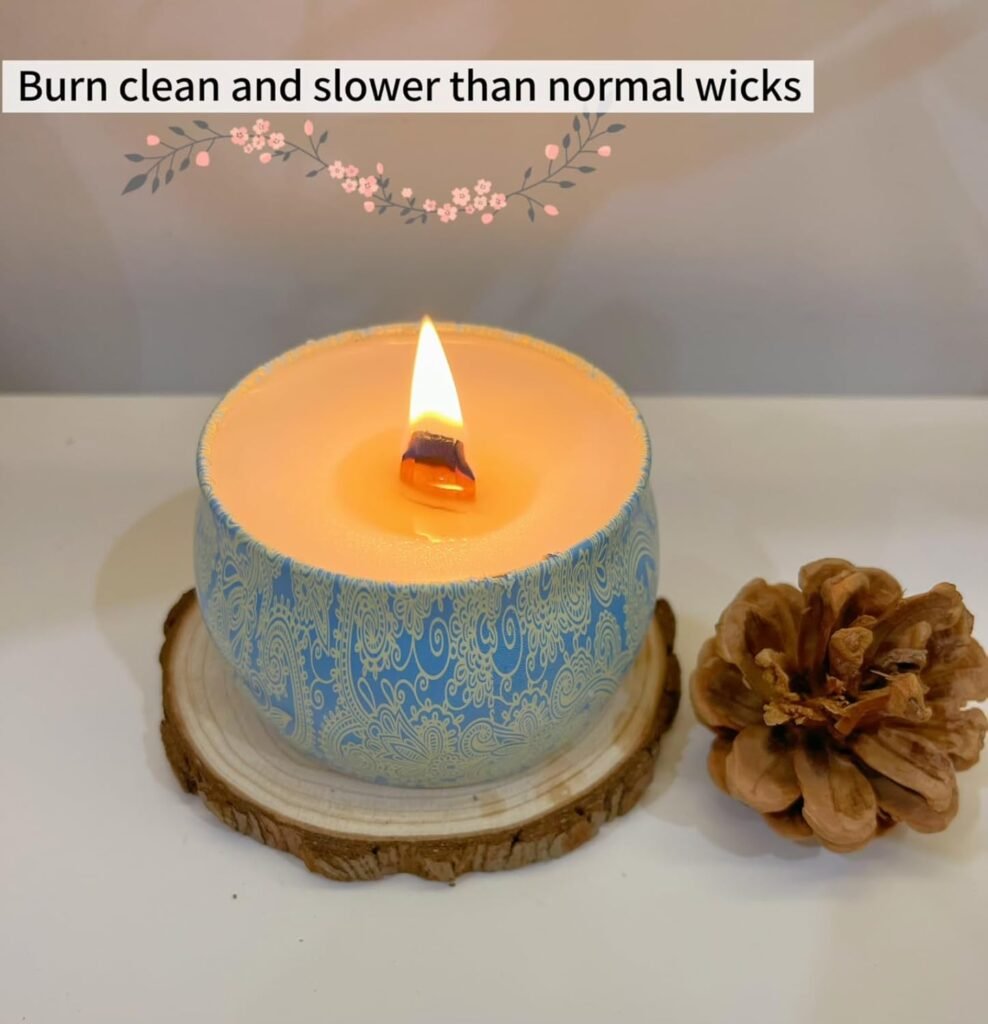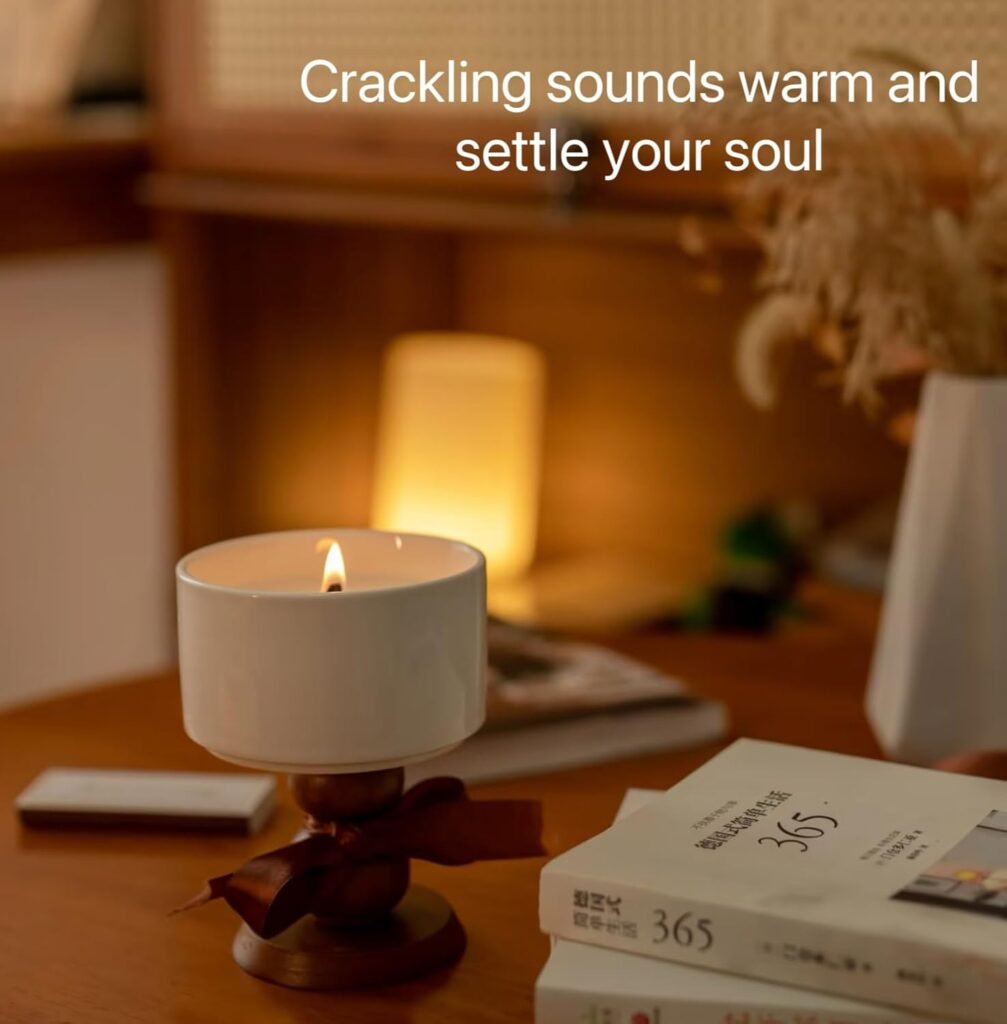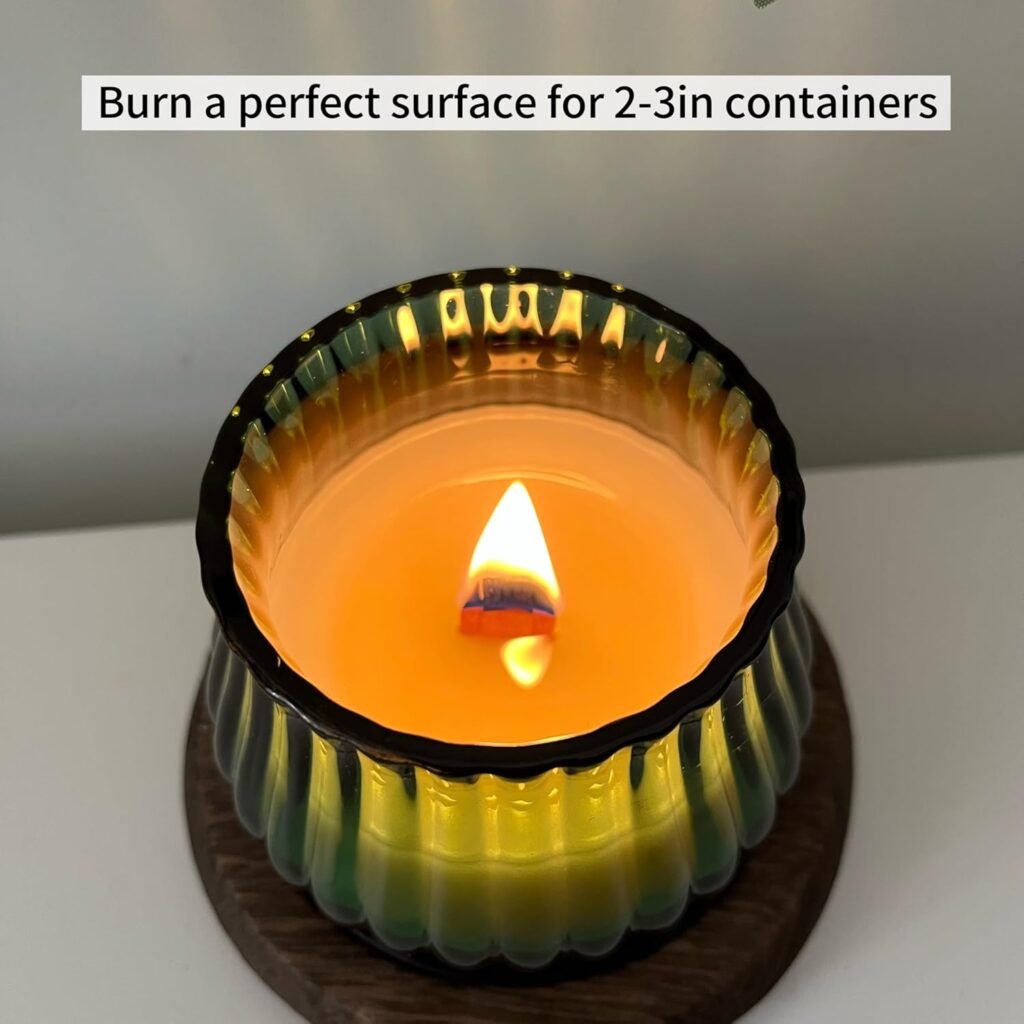Looking for a reliable wooden wick set that gives your candles a clean burn and cozy crackle?
Product overview: 30 Sets Double-Layered Smokeless Cherry Wood Candle Wicks, Long Lasting Flame, Easily Burn, Candle Cores with Stand and Glue Dot, Warning Label for DIY Candle Making
This set is designed for makers who want a consistent, long-lasting wooden wick without the hassle of laminating thin strips yourself. You get double-layered cherry wood cores, metal bases, and adhesive stickers, plus a warning label to keep safety front and center for your DIY candle projects.
Why this product stands out
The double-layered construction saves you time and gives a sturdier, more consistent flame than single-layer wooden wicks. Because they’re made from cherry wood, the wicks produce a pleasant crackling sound that many people find relaxing while also helping with scent diffusion.
What you get in the box
You’ll receive 30 sets of double-layered wooden wicks, 30 metal bases, and 40 adhesive wick stickers. The extra stickers give you some flexibility if you need to reposition wicks during setup or have a few practice runs.
Packaging and extras
The items usually come packaged to prevent breakage during shipping, and the inclusion of a warning label helps you meet basic safety expectations for DIY candles. You’ll appreciate not having to source separate bases or adhesives for many small projects.
Product specifications
This section breaks down the core measurements and counts so you can easily confirm fit for your jars and molds. Dimensions and counts matter when planning wick selection for different wax types and container sizes.
| Item | Detail |
|---|---|
| Wick type | Double-layered cherry wood |
| Sets included | 30 sets |
| Metal bases | 30 pcs |
| Wick stickers | 40 pcs |
| Dimensions (first layer) | 5.1 x 0.5 inches |
| Dimensions (second layer) | 5.1 x 0.2 inches |
| Total thickness | ~1.5 mm |
| Typical uses | Container candles, DIY projects, decor |
| Special features | Smokeless, long-lasting, crackling sound |
How to interpret these specs
The two-layer thickness and length make these wicks suitable for many container candles, especially when paired with the included metal bases for secure positioning. The 1.5 mm thickness is a middle-ground size that tends to work well across soy, paraffin, and blend waxes with appropriate testing.
Performance: burning behavior and flame stability
You can expect a steady, centered flame when the wick is properly primed and matched to the wax and container. The double-layered core helps prevent tunneling and provides a longer, more reliable burn compared with thinner single-layer wooden wicks.
Flame characteristics and smokeless claim
These wicks are described as smokeless and in many cases will burn cleanly if trimmed and used correctly. However, real-world results depend on factors like wax type, fragrance load, vessel diameter, and airflow around the candle.
Sound and sensory experience
The cherry wood produces a gentle, comforting crackle that adds ambiance without being intrusive. That crackle can enhance the overall experience, especially in cozy or quiet settings where you want more than just scent.
Scent diffusion and aroma throw
Wood wicks often create a slightly broader melt pool, which can help aroma oils diffuse more evenly across the wax surface. You’ll likely notice improved scent throw compared with some cotton wicks, but testing is still essential for each fragrance and wax combination.
Compatibility with various waxes
These wicks are compatible with soy wax, paraffin, coconut blends, beeswax, and many other container waxes, though results vary. You’ll want to perform a burn test for each wax/fragrance combination to determine optimal wick selection for your specific candle dimensions.
Specific wax notes
- Soy blends: Often pair nicely with wooden wicks because soy creates a stable melt pool.
- Paraffin: Generally produces a strong hot throw and can be used with these wicks, but watch for larger flame behavior.
- Beeswax: Burns hotter and may need testing to ensure the flame size remains safe and controlled.
Installation: step-by-step guide
Proper installation ensures the wick stays centered and burns correctly. Follow a consistent method so you reduce troubleshooting later.
Step 1 — Prepare your vessel and base
Clean your container of dust and oils so the metal base adheres well. Use one of the included wick stickers on the metal base for a quick and secure setup.
Step 2 — Attach the wick to the base
Peel a sticker, press the metal base to the sticky side, and ensure the wood core’s thicker layer sits upright and centered. Keep the wood wick vertical — you can secure the top with a clothespin or a wick centering tool while pouring.
Step 3 — Pouring and priming
Pour your wax at the recommended temperature for your wax type, typically around 130–150°F (54–66°C) for many soy blends. When the wax cools to a lower pour temp, the wick will be positioned and primed to burn evenly.
Step 4 — First burn
Trim the wick to about 1/8–1/4 inch (3–6 mm) before lighting for your first burn. Allow the candle to burn until you have a full melt pool to prevent tunneling and ensure the wick is properly seasoned.
Troubleshooting common issues
Even with a good wick, you may face challenges like mushrooming, erratic flame, or premature extinguishing. These issues usually come from mismatched wick/wax ratios or drafty environments.
Issue: Flame is too large or smoking
If the flame is large or producing smoke, trim the wick slightly and move the candle away from drafts. Re-test by burning in a calm room and monitor behavior over a one-hour period to see if trimming helps.
Issue: Candle tunnels or has weak scent throw
If tunneling occurs, try a larger initial burn to create a full melt pool across the surface. If scent throw is weak, test increasing fragrance load within the recommended range for your wax and wick combination.
Safety and the included warning label
The included warning label is useful for meeting basic safety needs and informing users of risks like flammable surfaces, drafts, and burn times. You should always follow standard candle safety practices: never leave a burning candle unattended, keep out of reach of children and pets, and place on a heat-resistant surface.
Practical safety tips
Trim your wick between burns, discard candles when 1/4 inch of wax remains, and avoid drafts or vibrations that can destabilize the flame. The metal bases help keep the wick steady, but they don’t replace safe placement and monitoring.
Maintenance and storage
Storing your wicks in a dry environment keeps them from warping or absorbing scents from the air. Keep them flat and away from heat to preserve shape and performance.
Handling unused wicks
If you don’t plan to use all 30 sets at once, keep extras in their original packaging or an airtight container. This prevents moisture exposure and reduces the chance of breakage.
Pros and cons
Laying out strengths and potential drawbacks helps you make informed choices before you buy. This set is strong for convenience and consistency, but you’ll still need to test for best performance.
Pros
- Ready-to-use double-layered wicks save time and increase reliability.
- Cherry wood provides a pleasant crackle and aids scent diffusion.
- Included metal bases and ample wick stickers mean fewer additional purchases.
- Works with many wax types when tested properly.
Cons
- Not universally perfect for every wax or large-diameter candle — testing is required.
- Wooden wicks can produce slight soot if trimming and drafts are not managed.
- Some fragrance/wax combinations may need thicker or thinner alternatives for best results.
Comparing to other wick types
Comparing this double-layered wooden wick to single-layer wooden wicks and cotton wicks can clarify where it fits in your toolkit. Each wick type has strengths depending on desired flame appearance, scent throw, and user preference.
| Wick type | Typical advantages | Typical drawbacks |
|---|---|---|
| Double-layered cherry wood | Stable flame, pleasant crackle, better longevity | Requires proper testing, may not fit all sizes |
| Single-layer wooden | Crisp crackle, lower cost | Can warp or burn inconsistently, shorter life |
| Cotton wicks | Predictable, traditional flame, wide availability | Less ambiance (no crackle), sometimes less scent diffusion |
How to choose between them
If you want the crackling ambiance and improved scent throw, this double-layered set is a solid choice. If you prioritize the classic steady flame of cotton or need a solution for very large candles, pair testing with alternate wick sizes.
Ideal projects and use cases
These wicks are excellent for container candles, decorative candles for events, and small-batch sales items. You’ll also like them for gift candles where the aesthetic and crackle add perceived value.
Specific project ideas
Make a cozy line of autumn-scented soy candles, craft scented candle gifts for friends, or create spa-style candles with subtle essential oil blends. The included bases and stickers simplify production for small runs.
DIY candle recipe using these wicks
This simple soy candle recipe is a great starting point to test the wicks and learn behavior with fragrance load.
Basic soy candle recipe (approx. 8 oz container)
- 8 oz soy wax flakes
- 0.6–0.8 oz fragrance oil (7–10% load)
- 1 double-layered cherry wood wick with metal base and sticker
- Pour at 125–135°F (52–57°C), cure 24–48 hours before first burn
Mix your fragrance thoroughly at recommended temperature, secure the wick with the metal base and sticker, and pour slowly. Allow the candle to cure before conducting a full burn test to evaluate scent throw and flame size.
Tips for achieving the best results
Small practices can drastically improve your outcomes when using wooden wicks. Follow consistent trimming, priming, and testing routines for reliable performance.
Practical tips
- Always trim to 1/8–1/4 inch (3–6 mm) before lighting.
- Avoid drafts and keep ambient room temperature consistent during burns.
- Perform multiple burn tests for each scent and wax ratio.
- Use a wick centering tool or a clothespin to keep the wick perfectly vertical while the wax cools.
How to measure success during testing
Keep a burn-testing log with vessel diameter, wax type, fragrance percentage, ambient conditions, and burn results. This data helps you quickly find the best combination and reduces wasted materials.
Key test observations
Record whether you get a full melt pool within 2–3 hours, how much soot if any appears, whether the flame leans, and the strength of cold and hot throw. These metrics guide wick selection adjustments for future batches.
Environmental and aesthetic considerations
Cherry wood is a natural material and can be seen as more artisanal compared with synthetic wick cores. The crackle can complement natural or rustic-themed products and adds sensory depth beyond smell.
Soot and cleanliness
While marketed as smokeless, any candle can produce soot if misused. Proper trimming and avoiding drafts mitigate soot, and keeping the wick trimmed will reduce particulate deposition on vessel walls or nearby surfaces.
Cost-effectiveness for makers
When you consider the included metal bases and extra stickers, this set saves both time and money versus sourcing items separately. The double-layered design reduces the labor of laminating thin strips for consistent performance.
Batch-production benefits
For small business or gift-making scale, not having to prep wicks saves hours. The uniformity also results in fewer rejects and better customer satisfaction when products perform consistently.
Frequently asked questions (FAQ)
This section covers questions you’re likely to have when using these wicks. If something isn’t behaving as expected, refer to these common answers.
Will these wicks work with gel wax?
Gel wax can be unpredictable with wooden wicks due to different heat dynamics; test a small jar before committing to a full batch. Gel often requires specific wick styles and careful testing to avoid brightly flaring flames.
How long should I burn the candle the first time?
Allow the first burn to create a full melt pool across the vessel diameter to prevent tunneling, typically 2–4 hours depending on vessel size. This conditions the wax and wick to burn more predictably on future uses.
Final verdict
If you make container candles and want an easy, reliable wooden wick option that improves ambiance and scent throw, this 30-set package is a practical, cost-effective choice. The double-layered cherry wood, metal bases, and extra stickers make setup straightforward, but you should still perform wick tests for optimal match with your wax and fragrance choices.
Who should buy this
You should consider this set if you’re an avid hobbyist, a small-batch candle maker, or someone who values the added sensory element of a crackling wooden wick. The convenience and consistency these wicks provide lower the barrier to producing professional-feeling candles.
Closing recommendations
Always run a few test candles across your most-used wax blends and fragrances before scaling up production. Use the included warning label and basic safety practices to protect users and meet general compliance expectations.
Final safety reminder
Never leave a burning candle unattended, trim the wick before each burn, and keep candles away from drafts and flammable materials. With proper handling and testing, these double-layered cherry wood wicks can deliver consistent, cozy performance in your candle-making projects.
Disclosure: As an Amazon Associate, I earn from qualifying purchases.
